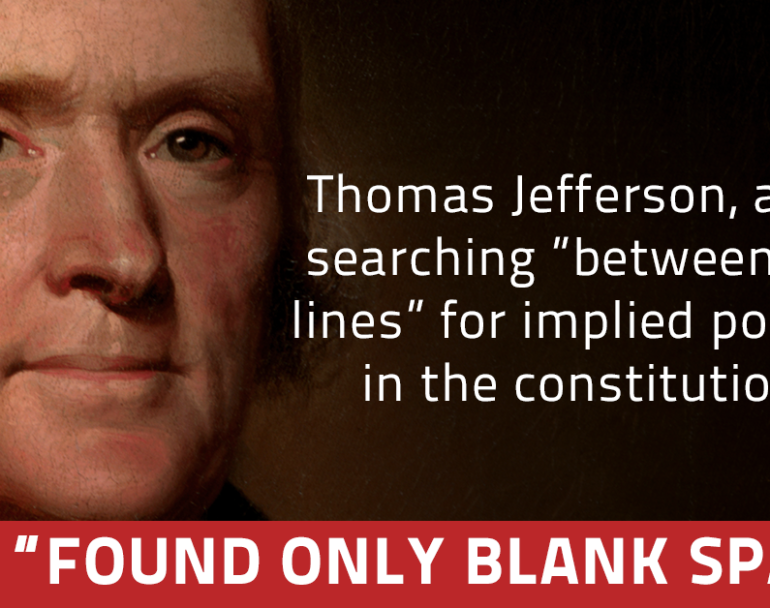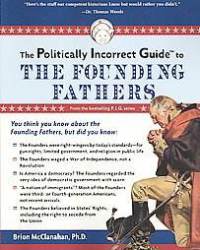
Who’s Supreme? The Supremacy Clause Smackdown
By: Brion McClanahan
When Idaho Governor C.L. “Butch” Otter signed HO391 into law on 17 March 2010, the “national” news media circled the wagons and began another assault on State sovereignty. The bill required the Idaho attorney general to sue the federal government over insurance mandates in the event national healthcare legislation passed. The lead AP reporter on the story, John Miller, quoted constitutional “scholar” David Freeman Engstrom of Stanford Law School as stating that the Idaho law would be irrelevant because of the “supremacy clause” of the United States Constitution.
In his words, “That language is clear that federal law is supreme over state law, so it really doesn’t matter what a state legislature says on this.” Now that Barack Obama has signed healthcare legislation into law, almost a dozen States have filed suit against the federal government, with Idaho in the lead. Battle lines have been drawn. Unfortunately, the question of State sovereignty and the true meaning of the “supremacy clause” may be swallowed up in the ensuing debate.
Engstrom’s opinion is held by a majority of constitutional law “scholars,” but he is far from correct, and Idaho and the thirty seven other States considering similar legislation have a strong case based on the original intent of the powers of the federal government vis-a-vis the States.
The so-called “supremacy clause” of the Constitution, found in Article 6, states, “This Constitution, and the Laws of the United States which shall be made in Pursuance thereof; and all Treaties made, or which shall be made, under the Authority of the United States, shall be the supreme Law of the Land; and the Judges in every State shall be bound thereby, any Thing in the Constitution or Laws of any State to the Contrary notwithstanding [emphasis added].”
The key, of course, is the italicized phrase. All laws made in pursuance of the Constitution, or those clearly enumerated in the document, were supreme, State laws notwithstanding. In other words, the federal government was supreme in all items clearly listed in the document.
A quick reading of the Constitution illustrates that national healthcare is not one of the enumerated powers of the federal government, so obviously Engstrom’s blanket and simplistic statement is blatantly incorrect, but his distortion of the supremacy clause goes further.
The inclusion of such a clause in the Constitution was first debated at the Constitutional Convention on 31 May 1787. In Edmund Randolph’s initial proposal, called the Virginia Plan, the “national” legislature had the ability to “legislate in all cases to which the separate states are incompetent” and “to negative all laws passed by the several states contravening, in the opinion of the national legislature, the Articles of Union.” John Rutledge, Pierce Butler, and Charles Pinckney of South Carolina challenged the word “incompetent” and demanded that Randolph define the term. Butler thought that the delegates “were running into an extreme, in taking away the powers of the states” through such language.
Randolph replied that he “disclaimed any intention to give indefinite powers to the national legislature, declaring that he was entirely opposed to such an inroad on the state jurisdictions, and that he did not think any considerations whatever could ever change his determination [emphasis added].” James Madison, the author of the Virginia Plan, was not as forthcoming as to his sentiment. Ultimately, Madison preferred a negative over State law and wished the national legislature to be supreme in call cases. But he was not in the majority.
The Convention again broached a federal negative on State law on 8 June 1787. Charles Pinckney, who presented a draft of a constitution shortly after Randolph offered the Virginia Plan, believed a national negative necessary to the security of the Union, and Madison, using imagery from the solar system and equating the sun to the national government, argued that without a national negative, the States “will continually fly out of their proper orbits, and destroy the order and harmony of the political system.” Such symbolism made for a beautiful picture, but it belied reality.
To most of the assembled delegates, the national government was not the center of the political universe and the States retained their sovereignty. Hugh Williamson of North Carolina emphatically stated he “was against giving a power that might restrain the states from regulating their internal police.”
Elbridge Gerry of Massachusetts was against an unlimited negative, and Gunning Bedford of Delaware believed a national negative was simply intended “to strip the small states of their equal right of suffrage.” He asked, “Will not these large states crush the small ones, whenever they stand in the way of their ambitious or interested views?”
When the negative power was put to a vote, seven States voted against it and three for it, with Delaware divided (and Virginia only in the affirmative by one vote). Roger Sherman of Connecticut summarized the sentiment of the majority when he stated he “thought the cases in which the negative ought to be exercised might be defined.” Since the negative did not pass, such a definition was unnecessary.
Thus, the federal government was supreme only in its enumerated powers and it did not have a negative over State law. Supremacy had limits.
By the time the Constitution was debated in the several State ratifying conventions in 1787 and 1788, the “supremacy clause” galvanized opponents of the document. The Constitution, they said, would destroy the States and render them impotent in their internal affairs. The response from proponents of ratification illuminates the true intent of the clause. William Davie, a delegate to the Constitutional Convention from North Carolina and proponent of the Constitution, responded to attacks levied on the “supremacy clause” by stating that:
This Constitution, as to the powers therein granted, is constantly to be the supreme law of the land. Every power ceded by it must be executed without being counteracted by the laws or constitutions of the individual states. Gentlemen should distinguish that it is not the supreme law in the exercise of power not granted. It can be supreme only in cases consistent with the powers specially granted, and not in usurpations [emphasis added].
Davie wasn’t alone in this opinion. Future Supreme Court justice James Iredell of North Carolina argued that, “This clause [the supremacy clause] is supposed to give too much power, when, in fact, it only provides for the execution of those powers which are already given in the foregoing articles.If Congress, under pretence of executing one power, should, in fact, usurp another, they will violate the Constitution [emphasis added].”
Furthermore, in a foreshadowing of nullification, Iredell argued that, “It appears to me merely a general clause, the amount of which is that, when they [Congress] pass an act, if it be in the execution of a power given by the Constitution, it shall be binding on the people, otherwise not [emphasis added]. Other ratifying conventions had similar debates, and proponents of the Constitution continually reassured wavering supporters that the Constitution would only be supreme within its delegated authority.
Most bought their assurances, though to staunch opponents, the Constitution still vested too much power in the central authority. The States would lose their sovereignty, they argued, and as a result, these men demanded an amendment to the Constitution that expressly maintained the sovereignty of the States and placed limits on federal power. Even several moderate supporters of the Constitution embraced this idea.
Ultimately, the three most powerful States in the Union, New York, Massachusetts, and Virginia, demanded that a bill of rights be immediately added to the Constitution; near the top of those recommended amendments on every list, a State sovereignty resolution. These ultimately became the Tenth Amendment to the Constitution, which reads, “The powers not delegated to the United States by the Constitution, nor prohibited by it to the States, are reserved to the States respectively, or to the people.”
Clearly the intent of this amendment was to mitigate any design the federal government had on enlarging its powers through the “supremacy clause.” If the power was not enumerated in the Constitution and the States were not prohibited by the Constitution from exercising said power, then that power was reserved to the States.
Several other constitutional “scholars” have weighed in on the debate in the last week, and each has invoked the “supremacy clause” to defend their opposition to State action against healthcare. Duke Law Professor Neil Siegel went so far as to suggest that the States are not reading the Tenth Amendment correctly. In perhaps the most outlandish statement of the debate, he also said, “Any talk of nullification bothers me because it’s talk of lawlessness.”
I guess Mr. Siegel has failed to consider that Idaho bill HO391 was passed by a legitimate legislative body elected by the people of the State. That would make it lawful.
 Of course, this debate ultimately boils down to loose interpretation verses strict construction. Thomas Jefferson had the best line on this issue. When asked to read between the lines to “find” implied powers, Jefferson responded that he had done that, and he “found only blank space.”
Of course, this debate ultimately boils down to loose interpretation verses strict construction. Thomas Jefferson had the best line on this issue. When asked to read between the lines to “find” implied powers, Jefferson responded that he had done that, and he “found only blank space.”
The original intent of both the “supremacy clause” and the Tenth Amendment indicate that Idaho and the other States challenging Obamacare are justified and correct and that the legal profession is either in the tank for the federal government or has not read either the debates of the Constitutional Convention and/or the State ratifying debates. This should make people like Engstrom and Siegel, rather than legitimate State law directed at unconstitutional authority, irrelevant.